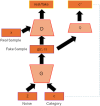A review of the applications of generative adversarial networks to structural and functional MRI based diagnostic classification of brain disorders
- PMID: 38686334
- PMCID: PMC11057233
- DOI: 10.3389/fnins.2024.1333712
A review of the applications of generative adversarial networks to structural and functional MRI based diagnostic classification of brain disorders
Abstract
Structural and functional MRI (magnetic resonance imaging) based diagnostic classification using machine learning has long held promise, but there are many roadblocks to achieving their potential. While traditional machine learning models suffered from their inability to capture the complex non-linear mapping, deep learning models tend to overfit the model. This is because there is data scarcity and imbalanced classes in neuroimaging; it is expensive to acquire data from human subjects and even more so in clinical populations. Due to their ability to augment data by learning underlying distributions, generative adversarial networks (GAN) provide a potential solution to this problem. Here, we provide a methodological primer on GANs and review the applications of GANs to classification of mental health disorders from neuroimaging data such as functional MRI and showcase the progress made thus far. We also highlight gaps in methodology as well as interpretability that are yet to be addressed. This provides directions about how the field can move forward. We suggest that since there are a range of methodological choices available to users, it is critical for users to interact with method developers so that the latter can tailor their development according to the users' needs. The field can be enriched by such synthesis between method developers and users in neuroimaging.
Keywords: brain connectivity; classification; deep learning; fMRI; generative adversarial network (GAN).
Copyright © 2024 Huynh and Deshpande.
Conflict of interest statement
The authors declare that the research was conducted in the absence of any commercial or financial relationships that could be construed as a potential conflict of interest.
Figures





Similar articles
-
Applications of generative adversarial networks in neuroimaging and clinical neuroscience.Neuroimage. 2023 Apr 1;269:119898. doi: 10.1016/j.neuroimage.2023.119898. Epub 2023 Jan 24. Neuroimage. 2023. PMID: 36702211 Free PMC article. Review.
-
Functional network connectivity (FNC)-based generative adversarial network (GAN) and its applications in classification of mental disorders.J Neurosci Methods. 2020 Jul 15;341:108756. doi: 10.1016/j.jneumeth.2020.108756. Epub 2020 May 4. J Neurosci Methods. 2020. PMID: 32380227 Free PMC article.
-
The Use of Generative Adversarial Network and Graph Convolution Network for Neuroimaging-Based Diagnostic Classification.Brain Sci. 2024 Apr 30;14(5):456. doi: 10.3390/brainsci14050456. Brain Sci. 2024. PMID: 38790434 Free PMC article.
-
Brain Tumor Classification Using a Combination of Variational Autoencoders and Generative Adversarial Networks.Biomedicines. 2022 Jan 21;10(2):223. doi: 10.3390/biomedicines10020223. Biomedicines. 2022. PMID: 35203433 Free PMC article.
-
Combating COVID-19 Using Generative Adversarial Networks and Artificial Intelligence for Medical Images: Scoping Review.JMIR Med Inform. 2022 Jun 29;10(6):e37365. doi: 10.2196/37365. JMIR Med Inform. 2022. PMID: 35709336 Free PMC article.
References
-
- Alarsan F. I., Younes M. (2021). Best selection of generative adversarial networks hyper-parameters using genetic algorithm. SN Comp. Sci. 2:283. 10.1007/s42979-021-00689-3 - DOI
-
- Arjovsky M., Chintala S., Bottou L. (2017). “Wasserstein generative adversarial networks,” in International Conference on Machine Learning (Sydney, NSW: PMLR; ), 214–223.
Publication types
LinkOut - more resources
Full Text Sources

